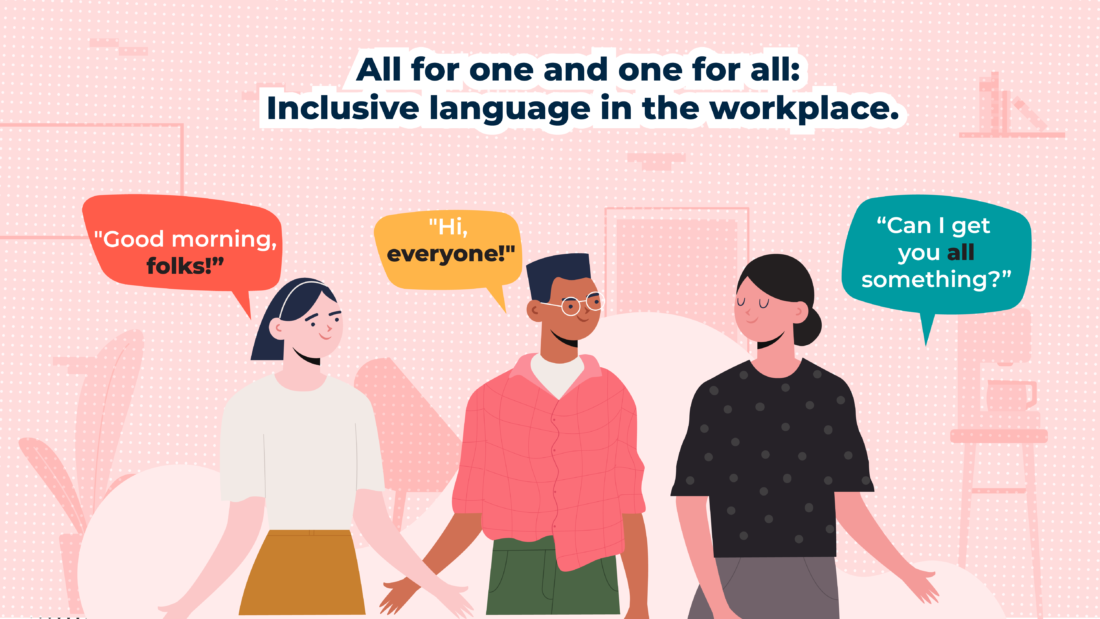The words we use every day have tremendous power, whether it is referring to people, places, things, ideas or concepts. We use words every day to communicate important beliefs, thoughts and facts. Inclusive language avoids biases or prejudice that might subconsciously creep into our communications if unchecked. Here we will be focusing on language at the intersections of gender and sexuality. Subtleties in language can be inclusive or exclusive, the onus is on us to ensure we have checks and balances for the language we present to the world.
There is a plethora of words in our vocabulary that allude to an exclusionary culture at the workplace. Exclusion can be subtle, pervasive and oblivious to the untrained eye. When we talk about exclusion we aren’t talking only of gendered bathrooms, although that is an important aspect of exclusion as well. We are instead speaking of the instances when leadership may hold a conference and announce “I’m looking for the best man for the job! Someone who is really dedicated to work and can be present for long hours.” This interaction is already coded, the person in the position of power has the idea of someone specific in mind: A single cisgender heterosexual man.
Exclusion isn’t always overt, it happens when the trans co-worker in the room has barely shared a word, and feels they don’t have space to do so, because leadership hasn’t made space with a simple check-in. Exclusion can take shape as talks around the water cooler, where colleagues are sharing their vacation plans and the queer colleague can’t share theirs because they are in a queer-coded relationship and don’t know where the organisation stands on this dynamic. Exclusion occurs when a person has to decide between safety and authenticity. Exclusion impacts productivity, when co-workers don’t feel seen or heard, they stop sharing their valuable insights to the project, it also creates a culture of deceit and doubt. Colleagues who feel excluded can withdraw from participating elsewhere as well.
There is tremendous space for inclusion of the diverse talent existing within the organisation. But oftentimes leadership might not be aware of this fact. Creating an inclusive culture builds a safe space for diverse talent to reach their potential. Inclusive language is a small piece in the diversity puzzle.
But inclusive language is the tip of the iceberg. It indicates to potential candidates, especially from diverse talent pools, that your workplace is psychologically safe for them to maximize on their abilities and how they will be evaluated in their work. When we have linear practices of assessing folks, we lose out on what our talent can bring to the table. Linear means using a very rigid model to box people and their creativity in. Appraisals especially should consider the range and the rainbow of talent that your workers bring into the workplace. How can we home in on the skills that exists in our employees? Innately. Linda from marketing may not be a great sales agent, but her home budgeting skills may be utilized for accounts or for analysing numbers in portfolios for presentations. So, how do we unearth these “hidden” superpowers? The first step is inclusive language, language is a gateway tool to ensuring folks in the workplace feel psychologically safe enough to open-up about their authentic selves.
Language can be a principal barrier to progress. According to many social science research studies, language is one of the leading impediments to candidates considering positions at an organisation. Inclusive language can include:
| Exclusive Language | Inclusive Language |
| Mr./Mrs./Ms. | Mx. |
| Best man for the job | Best person for the job |
| Ladies and Gentlemen | Folks |
| Hey guys! | Hey friends/team/people/everyone/superstars |
| Chairman | Chairperson |
| Waiter/Waitress | Server/Wait staff |
| Man Up | Toughen up/Chin up |
These are small but incremental changes that can be easily incorporated in our lexicon with a little effort.
There is another tool by which we can measure our inclusivity in our official communications. It is called the Agentic-Communal Spectrum. The agentic vs. communal spectrum determines if the phrases we are using creates space for participation from all talent or only cis able-bodied savarna men. Agentic language is independent, confident and decisive, whereas Communal language is warm, helpful and supportive. Among cis people, men are considered to be Agentic while women are viewed to be more Communal. It is this disparity in perception that bars people from being fully present and participative in the process of recruitment. In a study conducted by Erin Oldford, an assistant professor of finance at Canada’s Memorial University of Newfoundland, and her colleague John Fiset, of Canada’s Saint Mary’s University, found that women respond more positively to job ads that use communal language instead of agentic for the same positions. According to a BBC article, “The results suggest that tweaking the language of job postings may help to improve the gender diversity of job applicants, particularly in male-dominated fields like finance.” So, instead of saying “Strong leader with competitive spirit needed” you might want to use “Collaborative and dependable HOD needed”.
Though inclusive language is a small cog in the machine of a well-oiled business, it is an important cog. One when maintained and implemented well can work wonders in the sense of belonging employees can feel in an organisation. We consider sense of belonging because it is one of the most important factors in gauging whether the culture at an organisation is inclusive of all folks – employees feel most heard and valued when they experience this sense of belonging. Small steps can lead to big possibilities.
 Cart is empty
Cart is empty 

